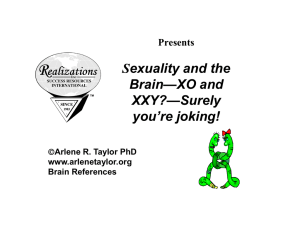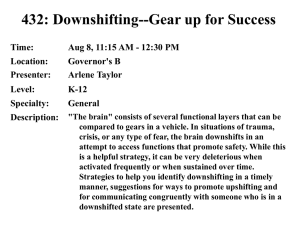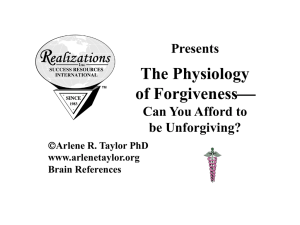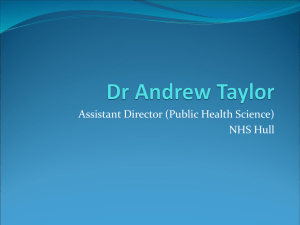Description Arlene R. Taylor PhD Realizations Inc In situations that
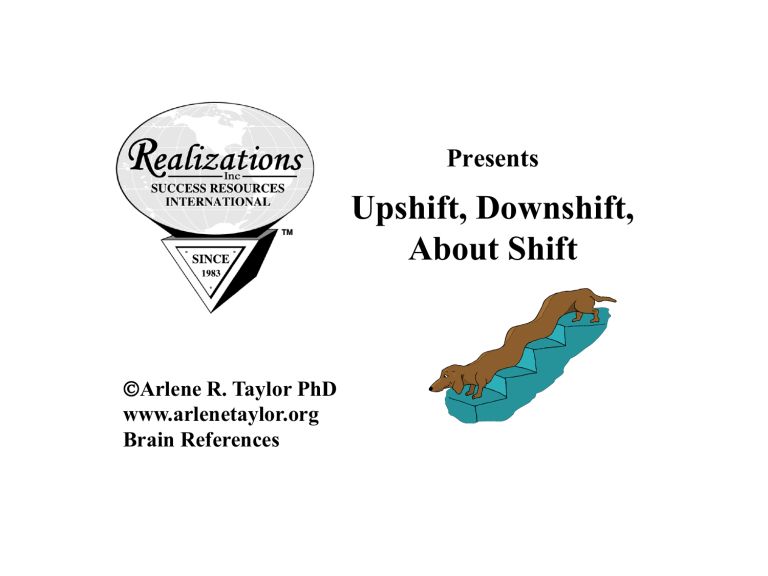
Arlene R. Taylor PhD www.arlenetaylor.org
Brain References
Presents
Upshift, Downshift,
About Shift
Brain Phenomenon
Arlene R. Taylor PhD Realizations Inc
The term downshifting is a label for a natural brain phenomenon
It describes the brain’s response to a perceived lack of safety
It is designed for bona fide threats in the short term only
Metaphoric Term
Arlene R. Taylor PhD Realizations Inc
Compare brain downshifting to a vehicle’s automatic transmission that shifts up/down automatically as needed in response to the environmental conditions it encounters
Brain downshifting occurs automatically in response to the degree of threat perceived by the brain (from 3 rd to 2 nd or 1 st )
Description
Arlene R. Taylor PhD Realizations Inc
In situations that involve trauma, crisis, fear, or any type of threat the brain tends to direct its attention and energy automatically toward lower brain areas attempting to access functions it hopes will promote safety
The person experiences a sense of anxiety or perceives a lack of safety rather than the excitement of a challenge
Brain Layers or Gears
Arlene R. Taylor PhD Realizations Inc
McLean’s Triune Brain is a model for understanding downshifting more easily . . .
Each brain layer contains distinct functions – although all systems interact continually
The brain can shift up and down through these brain layers or gears . . .
Reptilian Layer – 1
st
Gear
Arlene R. Taylor PhD Realizations Inc
Brain stem, Cerebellum (subconscious)
Processes the present only
Perceives positives easily
Houses stress responses (fight-flight, tend-befriend, conserve-withdraw) and dominates when threat is perceived
Provides awareness of your outer sensory environment
Reptilian 1
st
Gear, Cont’d
Arlene R. Taylor PhD Realizations Inc
Is egocentric and loosely resembles the “id”— I am here and it’s all about me!
Doesn’t use language but perceives the internal mental pictures language creates
Houses the Reticular Activating System that influences the EAI continuum
Usually the last portion of the brain to die
Mammalian Layer – 2
nd
Gear
Arlene R. Taylor PhD Realizations Inc
Limbic System Structures (subconscious)
Perceives present and past
Perceives positives easily
Processes information 80,000 times faster than the thinking brain layer
Transfers information from short to long term memory; assembles associations for memory recall (search engine)
Mammalian 2
nd
Gear, Cont’d
Arlene R. Taylor PhD Realizations Inc
Loosely resembles the “ego” — I am here … but so are you
Processes the sense of smell
Directs immune system function
Generates emotional impulses
Provides the foundation for relationships with its tools of emotion
Neo-Cortex Layer – 3
rd
Gear
Arlene R. Taylor PhD Realizations Inc
Cerebrum (eight lobes and consciousness)
Registers awareness of present, past, and future
Perceives positives and negatives
Decodes all sensory data except for smell
Limitless potential for processing concepts
Uses all forms of language with complex analysis
Neo-Cortex 3
rd
Gear, Cont’d
Arlene R. Taylor PhD Realizations Inc
Loosely resembles the “superego” – can think of the good of others and do self-care
Pre-frontal cortex contributes executive aspects ( e.g., abstract thought, metaphor, planning, goal-setting, paying attention, conscience, willpower, morality)
Can process 125 bits of information and 40 bits of speech per second
“Give Up” to “Get”
Arlene R. Taylor PhD Realizations Inc
Fail to recall (e.g., people tend to recall less than 15% of what was told to them during a crisis)
Decrease in cognitive learning
Develop or activate phobias
Accelerate the aging process
Alter immune system
Consequences, Cont’d
Arlene R. Taylor PhD Realizations Inc
Experience a reduced ability to take cues into consideration
Less able to engage in complex mental tasks (e.g., decreased creativity)
Fail to see interconnectedness or generate solutions for problems
Reactivate old learned beliefs and patterns of behaviors or relapse into addictive behaviors regardless of available information
Consequences To Learning
Arlene R. Taylor PhD Realizations Inc
Downshifted people can do some things well -- simple skills or rote memorization -because the brain perseverates under threat, and repetition provides a sense of safety when the brain feels unsafe
Repetition is compatible with many traditional parenting and teaching rewardpunishment-based systems and practices
Valid Fear
Arlene R. Taylor PhD Realizations Inc
Alerts you to potential/real danger
Identify the worst thing that could happen
Evaluate possibility versus probability
Can you do anything about the situation?
If yes, take appropriate action
If no, practice the Serenity Prayer …
Imagined Fear
Arlene R. Taylor PhD Realizations Inc
Usually involves negative thinking
Sabotages problem-solving
Is unlikely to improve the odds
Typically represents learned behavior
To change the way you feel, you must change the way you think!
#1 Upshifting
Arlene R. Taylor PhD Realizations Inc
Identify behaviors you’ve exhibited when situations did not go well and when you were likely downshifted
sighing, defending, stonewalling, arguing, crying, yelling, avoiding, pouting, whining, overreacting, overcomplying, fighting, isolating, overconforming, withdrawing (often related to fear —real or imagined)…
#2 Upshifting
Arlene R. Taylor PhD Realizations Inc
Identify factors that have triggered your downshifting in the past so you can be better prepared in the future
Trauma or crisis…
Illness, fatigue, overwork…
What someone said to or about you…
Perceived negative experience…
#3 Upshifting
Arlene R. Taylor PhD Realizations Inc
Identify patterns of behavior related to your downshifting
When and/or where?
Appropriate to the situation or not?
Become a “victim” or an “offender?”
Length of time downshifted?
What tends to upshift you?
Your Strategies
Arlene R. Taylor PhD Realizations Inc
Upshift using a pre-planned strategy
Think of something humorous and choose to laugh
Engage in positive self-talk
Identify something to appreciate (it is physiologically impossible to be fearful and appreciative at the same time)
Exercise (especially cross-lateral)
Strategies, Cont’d
Arlene R. Taylor PhD Realizations Inc
Visualize yourself in a safe place
Contract with yourself to
“deal with it later in the day”
Engage in a task over which you have some control
Sing, meditate, pray, recite a mantra
Access your support system
Caveats
Arlene R. Taylor PhD Realizations Inc
Develop strategies to prevent unnecessary downshifting, identify when your brain is downshifted, and get upshifted quickly
If communication is not going well with another brain, think “downshifting”
You cannot upshift another brain (even if your behavior triggered the downshifting) – you may be able to help the other brain feel safer so it can upshift on its own
